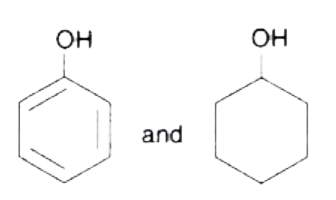Explain:
Electrolysis can distinguish between covalent and ionic compounds.
………………………………………………………………………………………….
Step-by-Step Text Solution:
1. Understanding Electrolysis: Electrolysis is a process that uses an electric current to drive a chemical reaction, typically to decompose a compound into its constituent elements or ions. It is commonly used to distinguish between ionic and covalent compounds.
2. Covalent Compounds: Covalent compounds are formed by the sharing of electrons between atoms. In their aqueous solutions, they do not dissociate into ions. As a result, they lack free electrons and ions that can conduct electricity. Therefore, when subjected to electrolysis, covalent compounds do not produce free atoms or ions, making the process inefficient and time-consuming.
3. Ionic Compounds: In contrast, ionic compounds are made up of positively and negatively charged ions held together by ionic bonds. When ionic compounds are dissolved in water, they dissociate into their respective ions, which are free to move. This movement of ions allows ionic solutions to conduct electricity effectively. Consequently, the electrolysis of ionic compounds occurs more rapidly and efficiently compared to covalent compounds.
4. Comparison of Electrolysis:
- Covalent Compounds:
- Do not dissociate into ions in solution.
- Lack free electrons.
- Require more time for electrolysis and are less efficient.
- Ionic Compounds:
- Dissociate into ions in solution.
- Have free electrons and ions that can carry electricity.
- Require less time for electrolysis and are more efficient.
5. Conclusion: By observing the efficiency and time required for electrolysis, one can distinguish between covalent and ionic compounds. Ionic compounds will conduct electricity and undergo electrolysis quickly, while covalent compounds will not.
---
- Covalent Compounds:
- Do not dissociate into ions in solution.
- Lack free electrons.
- Require more time for electrolysis and are less efficient.
- Ionic Compounds:
- Dissociate into ions in solution.
- Have free electrons and ions that can carry electricity.
- Require less time for electrolysis and are more efficient.
Topper's Solved these Questions
- CHEMICAL BONDING BOOK - ICSECHAPTER - CHEMICAL BONDING EXERCISE - WORKSHEET-3(Tick the correct answer)
5 Videos
- CHEMICAL BONDING BOOK - ICSECHAPTER - CHEMICAL BONDING EXERCISE - Additional Questions for Practice
32 Videos
- CHEMICAL BONDING BOOK - ICSECHAPTER - CHEMICAL BONDING EXERCISE - WORKSHEET-3(Give one word for the following)
10 Videos
- ANALYTICAL CHEMISTRY-USE OF AMMONIUM & SODIUM HYDROXIDEBOOK - ICSECHAPTER - ANALYTICAL CHEMISTRY-USE OF AMMONIUM & SODIUM HYDROXIDEEXERCISE - Additional Questions
6 Videos
- CHEMISTRY 2011BOOK - ICSECHAPTER - CHEMISTRY 2011EXERCISE - SECTION-II
48 Videos
Similar Questions
Knowledge Check
Which of the following contains both covalent and ionic bonds?
ACCl4BCaCl2CNH4ClDH2O
How can you distinguish between an alcohol and an acid?
View SolutionHow can you distinguish between an alcohol and an acid?
View SolutionExplain the features that distinguish between the two
Plasma and serum
View SolutionGive a chemical test to distinguish between the following pairs of compounds:

View SolutionDistinguish between : Simple epithelium and compound epithelium
View SolutionState four major physical properties that can be used to distinguish between covalent and ionic compounds. Mention the distinguishing features in each case.
View SolutionExplain the process of electrolysis.
View Solution
